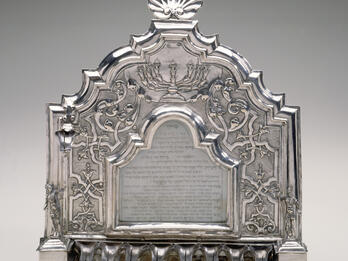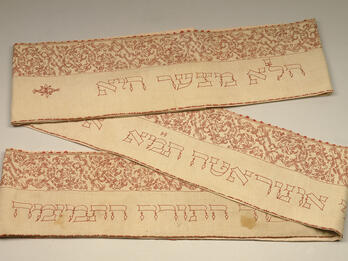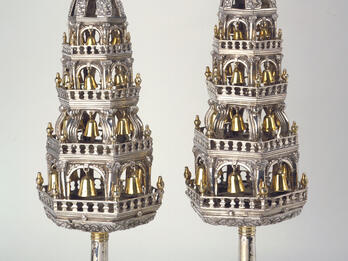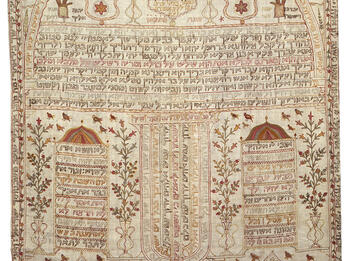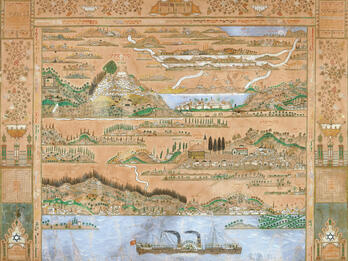Showing Results 61 - 70 of 83
Restricted
Image
This wooden tevah—a stand or reader’s platform used for supporting Torah scrolls—was made and used in Yemen. It was the practice in Yemen for boys to become active participants in synagogue services…
Contributor:
Artist Unknown
Places:
Qasimid State (Yemen)
Date:
18th Century
Subjects:
Categories:
Restricted
Image
This partially gilt-silver Torah crown from Poland is studded with semi-precious stones. Its two-tiered base is typical of Torah crowns from Eastern Europe. It is inscribed in Hebrew with the words,…
Contributor:
Artist Unknown
Places:
Polish-Lithuanian Commonwealth (Poland)
Date:
1729
Subjects:
Categories:
Public Access
Image
These Torah mantles, thought to be created in the Netherlands, are embroidered and have fringed borders. The mantle on the right is sumptuously adorned with brightly colored flowers, along with panels…
Contributor:
Artist Unknown
Places:
Dutch Republic (Netherlands)
Date:
1735–1737
Subjects:
Categories:
Public Access
Image
This Hanukkah lamp was made in Nuremberg, Germany, where it was characteristic in the eighteenth century for Hanukkah lamps to include a parchment with the blessings for lighting. At the time, however…
Contributor:
Matheus Staedlein
Places:
Nuremberg, Holy Roman Empire (Nuremberg, Germany)
Date:
1716–1735
Subjects:
Categories:
Public Access
Image
This Torah binder is one of the earliest examples from Italy. The binder (also known as a wimpel) was intended to accompany the male child through his lifetime, through the stages of his circumcision…
Contributor:
Honorata Foa
Places:
Date:
1582/3
Subjects:
Categories:
Public Access
Image
These silver and filigree Torah finials used by Amsterdam’s Ashkenazic community are shaped like four-tiered towers. They have gilt bells in their arches and gilt urns on their corners and are topped…
Contributor:
Artist Unknown
Places:
Dutch Republic (Netherlands)
Date:
1650–1700
Subjects:
Categories:
Public Access
Image
This Torah binder, made for boys at birth and later brought by young men as a symbol of participation in the synagogue, illustrates the fixed nature of traditional gender expectations.
Contributor:
Koppel ben Moses Heller
Places:
Munich, Kingdom of Bavaria (Munich, Germany)
Date:
1814
Subjects:
Categories:
Restricted
Image
This Torah curtain was made in Ankara, Turkey. The motifs of a central menorah and hands making the priestly blessing were common in other Ottoman Jewish ritual folk art. Embroidered verses from the…
Contributor:
Artist Unknown
Places:
Angora, Ottoman Empire (Ankara, Turkey)
Date:
1826
Subjects:
Categories:
Public Access
Image
This remarkable illustration is at the same time a shiviti—traditionally, a decorative plaque bearing the verse: “I am ever mindful of the Lord’s presence”—and a topographic map of the land of Israel…
Contributor:
Moses Ganbash
Places:
Constantinople, Ottoman Empire (Istanbul, Turkey)
Date:
1838–1839
Subjects:
Categories:
Public Access
Image
This kiddush cup and wine carafe by the master glass engraver Daniel Henriques de Castro displays his delicate technique, known as stippling. Though it is most common for kiddush cups, used for the…
Contributor:
Daniel Henriques de Castro
Places:
Amsterdam, Netherlands
Date:
ca. 1860





